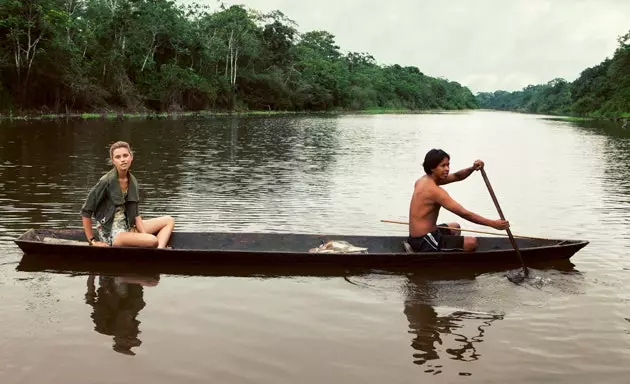
Navigating the Amazon by canoe
As soon as I arrived I surprised the buzzards, black birds and scavengers, lurking on the tin roofs of the stilt huts of the Bethlehem neighborhood , which surrounded the port. Others of those birds, as thick as turkeys, disputed with their pecks the human detritus that covered the shore, while naked children splashed in the muddy water of the river, screaming.
Indians in canoes, peque-peque (motor boats) and rafts brought fish, vegetables and fruit to market and large old ferries unloaded all kinds of merchandise, from butane cylinders to ice and cases of La Cuzqueña beer . The dock was made of wood and floated. In this way it was prevented from being destroyed by the frequent and unexpected floods of the great river.
I crossed the port among porters, taxi drivers, street vendors, transporters, and all kinds of cripples, beggars, women in tight clothes and representatives of inns and pensions who grabbed your arm. The neighborhood of Belén was located on the edge of the river and was made up of unpainted wooden shacks , supported by stilt houses with braided palm roofs or corrugated iron sheets. Others simply floated on rafts stranded in the river by heavy stones or cement blocks. Indians and mestizos lived there, the poorest in the city, who threw their daily waste into the water. no one knew how many there were . Some more than sixty thousand, others more than seventy and most more than one hundred thousand. When it had grown, as then, they improvised sidewalks using suspension bridges of boards. They called it the “poor man's Venice”.
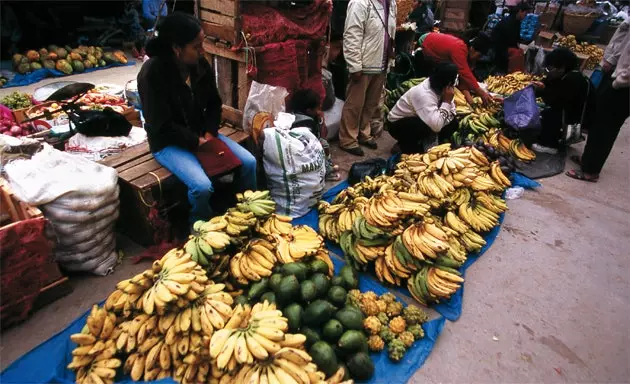
Iquitos downtown market
I had an appointment in a tavern in the market, called Paco's corner , run by a Galician. The market was a long tunnel barely sheltered from the rain by awnings, lined with stalls selling everything you could eat, drink, wear, and cook. The fruits, exotic and strange, are piled up in unlikely piles, along with the freshwater fish , of species unknown to us, which were shown hanging from spikes, open or in the process of becoming so.
Among the mud and rubbish, I discovered the stalls of the healers with jars of all kinds of remedies based on bat blood, snake venom and mysterious roots which, they claimed, helped increase virility. Paco's corner was a shack as long as a train car, plunged into darkness. Paco, the Galician, who later turned out to be Portuguese , he weighed one hundred and thirty kilos and fanned himself sitting in an armchair. I told him I was looking for a room for the night, and a short, barefoot Indian woman of indeterminate age led me through the dark up some wooden stairs to a doorless room with eight beds, arranged in rows against the walls. I chose one, close to the only window, paid in advance and ventured out into the city.
By nightfall, I already knew that the city retained a notable, but deteriorated, urban area , in which a couple of squares and the old palaces of the rubber magnates stood out, converted into dilapidated shops. That was the banking and commercial area. Beyond, the streets were mud. I went to bed early. At about ten o'clock at night I woke up. The beds were full of guests. Three or four women with lipstick were hissing at the sleepers from the doorway. They usually call them 'vivantas'.
I went out to the street I arrived at a square and saw a strange party . There were people lying in the street completely drunk from beer , beer, while most jumped to dance to music, the Sitaracuy (name of an ant, whose sting is terrible), around palm trees, the humishas, from whose branches hung gifts. Meanwhile, the dancers, between jumps and races, pinched each other to the general rejoicing.
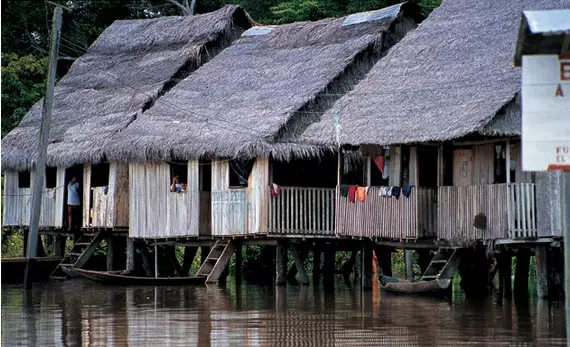
The typical stilt houses of the Amazon riverside in Iquitos
Now, **some time later, I return to Iquitos for a voyage up the river in a luxury vessel, the Delfin I **. The walk will be about one hundred and fifty miles along the Ucayali, after its union with the Marañon. I accompany a curious group made up of a young Dutch model, Anne, with languid blue eyes and delicate blonde hair, Alexander, the photographer, his assistant Javier, a stylist, and a Parisian dressmaker with his assistant, Elena, a Spanish brunette who lives in the French capital.
I find a completely different Iquitos . It is a city devoted to tourism. At least he tries. Its population has grown to over three hundred and fifty thousand inhabitants, the university has doubled the number of students enrolled and, although I still see the buzzards, the mudflats and the misery in the outlying neighborhoods and, above all, in the Belén neighborhood, the he city today has more banking centers than then , modern shops and various four-star accommodation, such as the ** Victoria Regia ** (Ricardo Palma street) and the Dorado Plaza Hotel , a category accommodation, in the Plaza de Armas.
Located between the banks of the Nanay and Itaya rivers, Iquitos is the capital of the state of Loreto and the most important city in the Peruvian Amazon , whose territory occupies half of Peru . In turn, Iquitos and its surroundings have a quarter of the total population of the territory. The Peruvian Amazon has the privilege of being the mother of the great Amazon river that practically crosses the American continent from west to east. Its source is in the buttresses of the Andean mountain range , with heights of more than 6,000 m, which pour their waters into the great Amazon basin.
But what is changing the city and the country is oil , the construction of oil pipelines in the middle of the jungle, power plants, dams and the indiscriminate felling of trees. National and international environmental groups and organizations maintain a hard fight against what they consider an attack on the Amazon jungle and its inhabitants, the indigenous peoples.
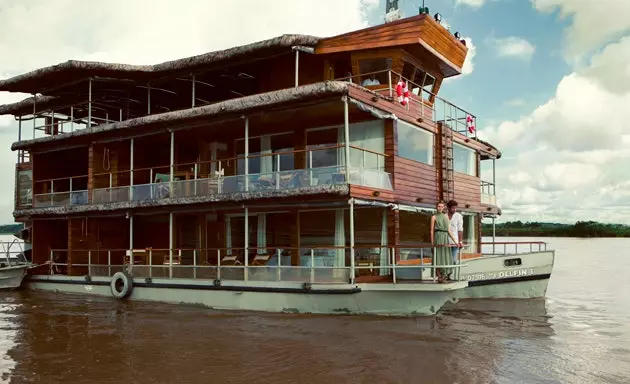
We boarded in Iquitos to cross the Amazon on the Delfin I
The journey begins with the welcome of Lissy Urteaga , a blue-eyed Lima native of Basque origin, manager and partner of the Amazon cruise company. She greets us at her floating restaurant and bar, Al Frio y Al Fuego, without a doubt the best in Iquitos, a long way from all the others. Located in a cocha (lagoon) it is accessed by boat from a private jetty located at Avenida de la Marina, 138 . The two-level restaurant is outdoors, to maximize the benefits of the Amazonian breeze, and also boasts a magnificent swimming pool.
Lissy has opted for traditional Amazonian food and products from the region. Haute cuisine and traditional foods : yucca, hearts of palm, fish from the great river and the best fruits and vegetables from the incredible Amazonian food reserve come together in an excellent gastronomic experiment. The national dish of Iquitos, and of the Peruvian Amazon, is the juanes , composed of chicken, hard-boiled egg, rice, chopped onion and spices, wrapped in bisao (banana) leaves and grilled. The patarashca dish is similar, but with fish.
By bus, we travel about one hundred and twenty kilometers on the new highway that connects Iquitos and Nauta, a fishing village on the left bank of the Marañón which has grown a lot due to tourism in recent years, inhabited above all by Cocama Indians. On the bus we meet a couple of newlyweds who will accompany us throughout the journey: Alexander and Aránzazu. In Nauta we boarded the Dolphin I . Our boat route will last four days along the Ucayali and will border part of the Pacaya-Samiría National Reserve , created in 1972, and about two million hectares, limited by the Marañón and the Ucayali and their tributaries the Pacaya and the Samiría, which form the so-called Ucamara depression. Which means that during most of the year this depression remains flooded by frequent floods.
Some inhabit it fifty thousand indigenous people, dedicated to fishing, hunting and farming of cassava, rice, pumpkins and chili in the lands free from the waters. The surpluses from their consumption are taken to Nauta and to the towns of Requena and Jenaro Herrera, and even to Iquitos. In that area they are mainly from the Cocama, Omagua, Shipibo, Moyoruna and Jíbara ethnic groups , who build their villages on the restingas or highlands, free from flooding and a refuge for jungle animals. Sometimes we saw them go by in their sharp canoes made by hollowing out a tree trunk. On one occasion we saw a family aboard a fast , a palm-roofed raft that slid down the river carrying a cage made of vines , full of fish. They were going to sell them to Iquitos. It would take seven days . An indigenous family that owns an outboard can be considered well off.
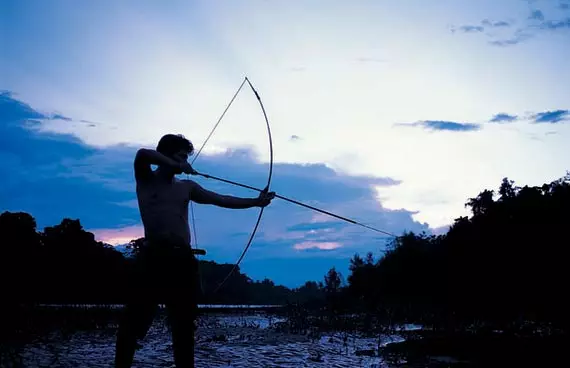
Many of the Amazon fishermen respect traditional indigenous techniques
The jungle is inhabited by capybaras, maquisapa monkeys, pumas, iguanas, crocodiles, sloths... and all kinds of snakes. But it is not easy to see them, they flee from humans. However, the birds are visible, from parrots, parrots, tuqui-tuquis, panguanas (jungle chickens), eagles, herons, kingfishers and fishing hawks... as well as fish, ranging from piraracús or piranhas to catfish or carachama. And, above all, the freshwater dolphins, called bufeos in this part of the Amazon and botos in the Brazilian. There are two varieties of these freshwater dolphins. The pink and the gray . The pink variety can weigh more than one hundred and twenty kilos, while the gray ones do not exceed sixty. The natives do not touch them. are taboo . Countless legends attribute human origin to them – inhabitants of the Atlantic – which has allowed this species to be preserved without the possibility of extinction. Docile as little dogs, we see them having fun and enjoying themselves in the igarapés (small rivers between islands), in the streams or in the arms of the river.
In the Amazon there are no defined seasons. Either it's raining or it's going to rain. The heat is constant and suffocating. It seems that we are in an oven. However, on the boat, with the constant breeze of their march, between four or five knots, plus the help of the air conditioning, the suffocation is not noticeable. We are going to cross two types of waters, black and white, even if they are brown. The black color is due to the humus remains of decomposing organic matter. , rich in tannins and iron oxide that causes the reddish tones of the water. When one slides in a canoe on them, a magical sensation is produced.
The Delfin I is a true luxury hotel , decorated with taste and restraint, and an ember of light in the dark jungle. It has three floors. Below, in the stern, are the engines, the landings of the two motorboats, the holds and the bilge, where the crew members sleep in hammocks. In the bow, two cabins, about twenty-five meters long, with an open terrace with sun loungers and a table. Perfect for leisurely contemplation of the landscape.
The second floor is passenger territory: aft are the kitchens and the dining room, where the chef's team works hard to prepare exquisite dishes. At the bow, two other cabins. Up on the bridge, the stern has become an elegant and comfortable lounge-bar, open to the contemplation of the great river and its wooded banks . The bow is the command bridge, where the captain, or helmsmen, steer the ship. Each of the four cabins, open by windows that can be closed with blinds, has field glasses with which you can watch the birds.
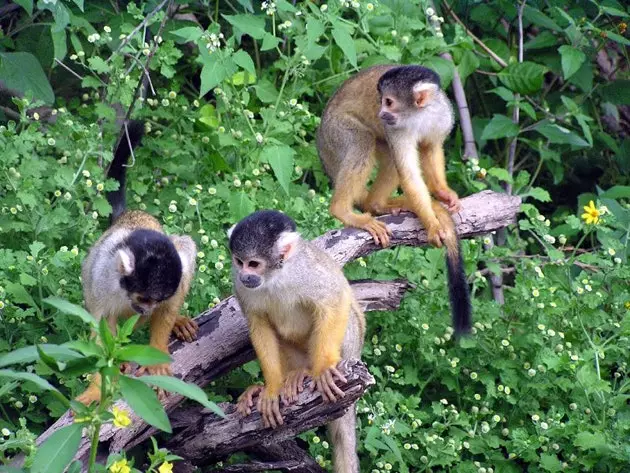
The Amazon howler monkey has a representative prehensile tail
The troupe, with her tireless and subtle model, works feverishly photographing her with all kinds of haute couture dresses and accessories, under the discreet gaze of the crew. Boat trips are frequent, commanded by naturalist guides , Juan and Juan Luis, impeccable in their uniforms, who speak more than correct English. His skill in the jungle is amazing . Both indigenous people are capable, among other things, of discovering a couple of small monkeys embracing each other and camouflaged on a trunk at more than two hundred meters. The same with birds, which are distinguished by their chirping or even their flapping wings. Or perceive the presence of scorpions , camouflaged liana snakes, or trace recent capybara tracks.
Perfectly organized, the boats take us fishing or for a walk in the jungle. It is also planned, swim in wetlands and emulate the Indians rowing a canoe . I did it through one of the most beautiful places in the already beautiful Nature Reserve. I mean the cocha (lagoon) Cantagallo or El Dorado, with waters like black mirrors that reflected the flowers and the twisted branches that protruded from the flood . Before the astonishing silence, one believes in another world. Perhaps in the world before it was invented. Very much like when you watch a storm from the terrace of the ship's cabin and see the huge gray bats frantic and frightened, lurching.
The newlywed couple returns to Lima by plane. The troupe stays in Iquitos. Alexander, the photographer, is willing to a photographic report by the Belén neighborhood , now a city district, with its own mayor and authorities. Nevertheless, he seems not to have changed at all his character of miserable and unhealthy area . What is new is that has been included in the tourist offices as something worth seeing, one of the charms of the city. While Alexander hires a bodyguard to accompany them to the Belén neighborhood –the precious cameras he carries can be a decoy for professional thieves and amateurs–, I'm going to visit him.
The Plaza de Armas and that of July 28 they are painted and clean and, in general, the central urban core much more presentable. Jirón Próspero street, especially between the Plaza de Armas and 28 de Julio, is the banking artery, headquarters of official organizations and modern electronics stores. Spanish Telefónica has devastated, everyone has a cell phone. And there are hardly any taxis, the famous "carry-carry". They have been replaced by the "motocar" , motorized tricycles at 2 soles the race. There are hundreds of them.
I'm looking for the Espresso , between Jirón Próspero and Sergeant Lores. The only place in the city where you could have coffee from a machine before. And I find it. A cabin of barely twenty meters, presided over by the old Italian coffee maker Mancini and by the owner, Don Pedro, just as fat as before yes The tables are discolored, as are the walls. The intellectuals of the city passed by there . His drawn portraits are still hanging. I ask for a “past coffee”, that's what espressos are called, and I sit down to contemplate the street. Today it is possible to order an espresso in hotels and in new restaurants.
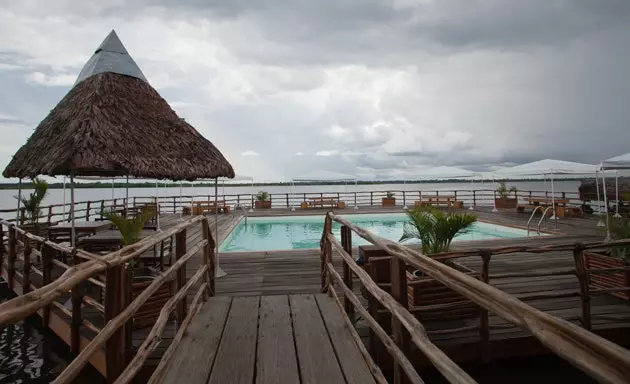
The Delfin I is a true luxury hotel
It takes half an hour to get to the Bethlehem Market walking through Jirón Próspero. I find it just as bustling, crowded, motley. Perhaps cleaner. There are no tourists, not even men . The majority of sellers and buyers are women. I see the “ruleteros”, pickpockets, bums, porters of whole pigs and I listen to Lucho Moreno, the Ecuadorian troubadour. I bought myself a bundle of mapochos for two soles fifty, strong cigars made from tobacco grown by the Indians. Later I buy a few camu camu , exquisite strawberries, and I enter the Paco's corner . It's still just as dark, gloomy. A cachaça drunk whimpers in a corner. Don Paco died and the bedroom doesn't exist either, they closed it. It was a matter of the municipality, they inform me.
Iquitos is about 116 meters above sea level. In the Amazon that means a good place to found a city. There are two Belén neighborhoods, the upper and the lower . The high one is next to the market, on solid ground, the low one, in the river. In the high live the well-to-do, that is to say, in the low, the others. I descend some muddy stairs and take a motorized canoe-taxi. He wants to cheat on me, of course. Two soles is enough for him to take me to the stilt bar that he frequented twelve years before . A shed painted green with no name. It was run by Doña Remedios, an old Indian woman who seemed carved from wood.
The taxi driver tells me that he knows where she is. I discover later that he has no idea and that the picture is still, with slight differences, the same as always. We couldn't find the bar. I tell him to stop at any. The barber in a boat passes by our side, a lady in her canoe-shop. Others who go to her affairs. About twenty meters away, a motorboat passes slowly, in parallel, full of tourists who greet everyone. The bar he takes me to has a wooden ladder nailed to it. I give him another sol as a tip and go upstairs. There are customers, two silent Indians and an old man, the boss. I ask for a photographer who walks the neighborhood. Nobody answers me. I know the Indians are silent . I repeat the question. The boss tells me that he hasn't seen anyone today. I order a pisco and go to the porch. Opposite is the jungle, the traffic of canoes, boats and small-small is constant.
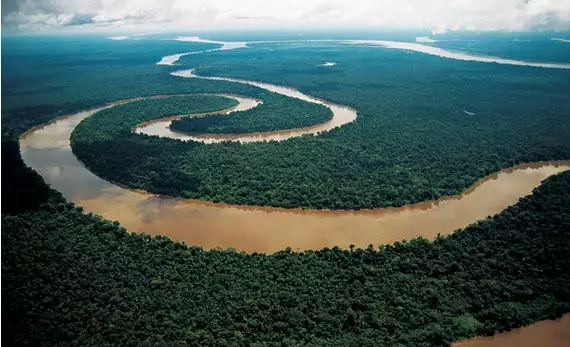
The Amazon practically crosses the American continent from west to east
How has this changed? They tell me that there is a medical center and that many ladies and people from the government come to ask. Maybe the change is starting and I haven't noticed . Tourists come to Iquitos looking for the Amazon, the exotic, others to experiment with ayahuasca. Fat, well-groomed madams approach the male tourists and offer them the merchandise. They have a special sense of smell to know who is and who is not. They usually explain that they are aunts or mothers and that their "girls" are the best of the best. The girls usually wait in a bar with a terrace called Costa Verde. One hour, one hundred soles. Earning a hundred soles in a while is equivalent to almost a month of work. In the Belén neighborhood, the prostitutes move around in boats. They are usually women in misery.
Javier, the photographer, Daniel, the Promperú representative, and I decided to go to dinner. Iquitos has changed. Now there is a drinking area, the Iquitos scene . It is located on the Malecón Taparacá, which overlooks the Amazon. There are the young people strolling or drinking and the inevitable tourists who sell trinkets and play an instrument. It is about five blocks between Nauta and Brasil streets, near the Plaza de Armas . The elegant terrace bars are full. The Dawn on the Arms, La Nuit, Le Bistrot and Fitzcarraldo stand out . Opposite, on the corner of Jirón Putumayo, is the old and elegant Palace Hotel , built during the rubber fever. Today it is used as Army Headquarters.
We had dinner at the Fizcarraldo, which still hasn't lost its look of an old bar. We ordered a fiery tortoise, alligator pork rinds –very tasty, I must admit– and cecina de tacacho . They inform us that the best disco in Iquitos is Noah Disc , in Fizcarraldo, 298. It is 500 meters long, has two slopes, five bars and prices that have little to do with those of the countries in the area and are more like the oversized ones that can be found in any European capital. It is no different from any luxury record from any country. There are many others, like the Disco Pub Birimbao , in Putumayo, fourth block, and the Adonis located on Avenida del Ejército.
We know that oil tankers arrive in Iquitos from the jungle by plane every other weekend. Where are they going? Al Dorado and the CNI Complex , at the end of Marqués de Cáceres street. And indeed, there they are. El Dorado is closed, but opposite, on a huge lot, a shed with a tin roof and a stage has been set up. It has the capacity for 400 or 500 people, more than half of them women. The Great Illusion Orchestra performs, along with go-go dancers in thongs. Noise makes conversation impossible but who needs to talk? The tankers shout for joy. That night more than 300 cases of beer were spent. Later, we all went to other clubs, but this is another story.
This report has been published in the number 52 from Condé Nast Traveler magazine.
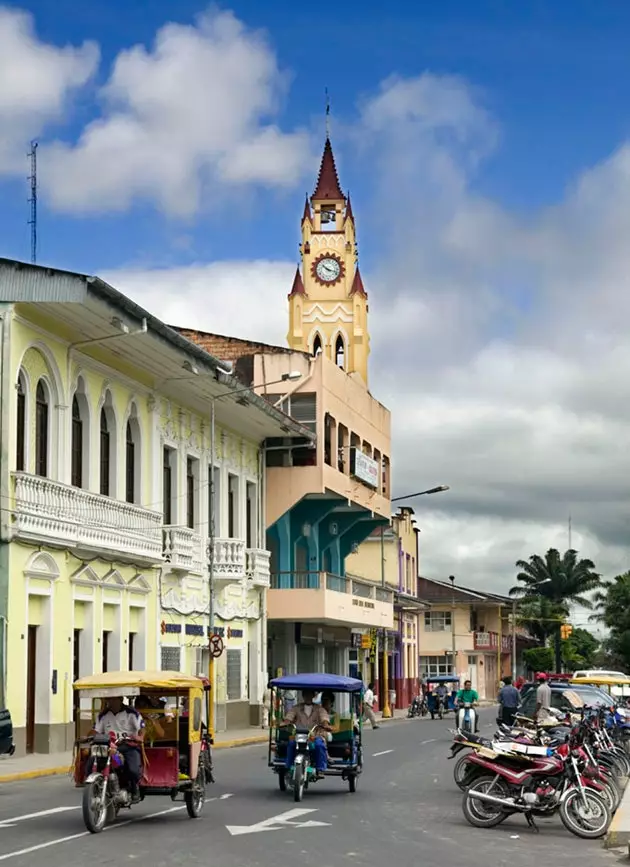
Iquitos Cathedral, neo-Gothic style, was built at the beginning of the 20th century in the Plaza de Armas
